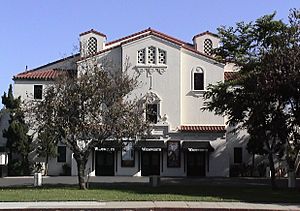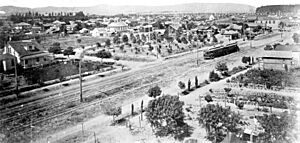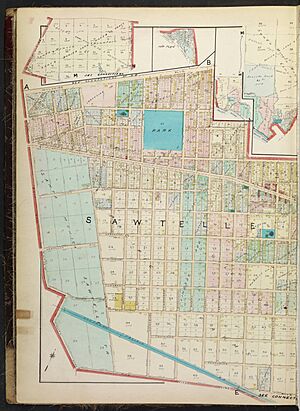Sawtelle, Los Angeles facts for kids
Quick facts for kids
Sawtelle
|
|
|---|---|

Wadsworth Theatre
|
|
| Country | |
| State | |
| County | |
| City | |
Sawtelle is a neighborhood in West Los Angeles, California. It is known for its lively Japanese American community. You can find many busy restaurants and unique movie theaters here. Sawtelle has a deep connection to Japanese-American history. Because of this, the area was named Sawtelle Japantown in 2015.
Sawtelle started as a small city around a special home for soldiers. This home was called the Pacific Branch of the National Home for Disabled Volunteer Soldiers. It later became the Sawtelle Veterans Home. The city of Sawtelle was created in 1899. It was named after W. E. Sawtelle, who managed the company that developed the land. Sawtelle was an independent city for less than 30 years. Then, it became part of the larger city of Los Angeles.
Contents
History of Sawtelle
Ancient Springs and Early Visitors
The land where Sawtelle is now has been important for thousands of years. This is because it has many natural springs. The Tongva people lived here in a village called Kuruvungna. This name means "place where we are in the sun." The Kuruvungna Village Springs still flow today. They are near University High School.
The first Europeans came to this area in 1769. Gaspar de Portolá and his group camped near the springs. They saw a busy community with lots of green plants. Later, in 1839, this land became part of a large ranch called Rancho San Vicente y Santa Mónica.
The Soldiers' Home and New Town
In 1888, the Pacific Branch of the National Home for Disabled Volunteer Soldiers opened nearby. This was a home for soldiers who had served their country. The home grew quickly, and new railroad lines were built to reach it.
The city of Santa Monica was already established. Its residents did not like the growing influence of the soldiers' home. So, in 1895, Santa Monica changed its school district borders. This was done to keep the soldiers' home out.
Even with Santa Monica's dislike, others were interested in the area. Many veterans lived there and received money from the government.
In 1896, a company bought land south of the soldiers' home. They hired S. H. Taft to build a new town. They first tried to name it "Barrett," but the postal service said no. The name was too much like "Bassett." So, in 1899, the town was officially named "Sawtelle." It was named after W. E. Sawtelle, a leader of the land company.
The soldiers' home became a popular spot. Tourists visited, and people bought land nearby. In 1906, it was a stop on a famous tour called the "Balloon Route." This tour took people from downtown Los Angeles to the ocean by streetcar. Many veterans' families moved to Sawtelle. This is how the community grew around the soldiers' home.
Becoming Part of Los Angeles
The city of Los Angeles was getting bigger in the early 1900s. It was adding more land, partly because of its new water supply. In 1913, Sawtelle residents started talking about joining Los Angeles. On May 14, 1917, they voted to join. The vote was very close.
Sawtelle's city leaders did not want to join Los Angeles. They went to court, saying the vote was not fair. While the case was still in court, something unusual happened. In 1918, the Los Angeles Police Department went to Sawtelle City Hall. They took most of the city's records.
Even after this, Sawtelle's leaders kept meeting. They met at the City Hall for two months. Then, they moved their meetings to the City Clerk's home. Sawtelle acted like a government in exile for over two years. They held meetings and tried to have elections.
In 1921, the California Supreme Court said the first vote to join Los Angeles was not valid. This ended a long and difficult disagreement. Sawtelle's leaders returned to their City Hall. They found that Los Angeles had taken some of their equipment.
However, in the next election, new leaders were chosen. These new leaders wanted Sawtelle to join Los Angeles. A second vote was held on June 2, 1922. This time, it passed by a large number of votes. Sawtelle officially became part of Los Angeles in July 1922.
Japanese American Community
Sawtelle's history is shaped by its Japanese American community. Many Japanese families moved here because of unfair rules in other parts of Los Angeles. Early Japanese residents often became farmers. They faced challenges like not being able to get bank loans. They also could not own land because of the California Alien Land Law of 1913.
By 1941, there were 26 garden centers in Sawtelle. Most of these were run by Japanese immigrants and their families. During World War II, many Japanese Americans were forced to leave their homes. This greatly changed the community.
Exploring Sawtelle's Geography
The name Sawtelle can mean different things. It can refer to a larger area that is part of Los Angeles. It can also mean a smaller area that is not officially part of Los Angeles. Sometimes, people use "Sawtelle area" to mean both.
The part of Sawtelle that is now part of Los Angeles is about 1.82 square miles. It is generally bordered by the Interstate 405 freeway to the east. National Boulevard is to the south, and Centinela Avenue is to the west. To the north are Bringham Avenue, San Vicente Boulevard, and the V.A. grounds.
There is also a smaller area of Sawtelle that is not part of Los Angeles. It is about 0.90 square miles. This area is completely surrounded by Los Angeles. It includes places like the Wilshire Federal Building and the Los Angeles National Cemetery.
Getting Around Sawtelle
Sawtelle has good public transportation. Buses are provided by Los Angeles Metro Bus and Santa Monica Big Blue Bus. You can also use Culver CityBus.
The Metro E Line train runs along the south side of Sawtelle. Its Sawtelle stop is at the Expo/Bundy station. A new train station, the Westwood/VA Hospital station, is planned to open in 2027. This will connect the area to Downtown Los Angeles.
Sawtelle is part of a special program called Slow Streets. This program limits car traffic and makes drivers slow down. It helps make neighborhood roads safer for people walking, jogging, and playing. In 2017, Sawtelle was named one of Los Angeles's most walkable neighborhoods.
Sawtelle Boulevard is a main street and the heart of the local Japanese community. Other important streets include Santa Monica Boulevard and Olympic Boulevard. Freeways like the Santa Monica Freeway and the San Diego Freeway are also nearby.
Arts and Culture in Sawtelle
Sawtelle is home to two special movie theaters. These "arthouse" theaters are important to the film community in Los Angeles.
- The Nuart Theatre was built in 1929. It shows independent films from different countries. It also has regular late-night showings of The Rocky Horror Show.
- The Laemmele Royal Theater was built in 1924. It is one of the last single-screen theaters in Southern California that still shows movies every day.
The Village recording studio is on Butler Avenue. Many famous music artists have recorded albums here. Some well-known albums include Steely Dan's Aja and Bob Dylan's Planet Waves. Many movie and TV show soundtracks were also recorded here. These include Toy Story 2 and The Shawshank Redemption. The studio has a famous mural on its south wall.
The Japanese Institute of Sawtelle is a cultural center. It serves the Nikkei community of West Los Angeles. It is located on Corinth Avenue.
Stoner Park is a popular spot in Sawtelle. It has tennis courts, a playground, a skate park, and a seasonal outdoor pool. There is also a recreation center and a Japanese garden.
Education in Sawtelle
Public Schools
Sawtelle is part of the Los Angeles Unified School District.
These elementary schools serve the Sawtelle area:
- Brockton Avenue School
- Richland Avenue Elementary School
- Nora Sterry Elementary School
- Westwood Elementary School (in Westwood)
These middle schools serve the Sawtelle area:
- Daniel Webster Middle School
- Emerson Middle School (in Westwood)
Students in the Sawtelle area attend University High School.
Private Schools
Sawtelle also has several private schools:
- Arete Preparatory Academy
- Brawerman Elementary School
- New Horizon School
- New Roads Elementary School
- Park Century School
- Saint Sebastian School
- Southern California Montessori School
- Wildwood School
The Asahi Gakuen is a weekend Japanese school system. Its Santa Monica campus is at Daniel Webster Middle School in Sawtelle. This school helps students learn Japanese language and culture.
Veterans Facilities in Sawtelle
The grounds of the former Sawtelle Veterans Home are also called Sawtelle. This home for soldiers and sailors was built in 1888. It included a hospital and a cemetery. This area is mostly north of Wilshire Boulevard.
Since 1977, this area has included the West Los Angeles VA Medical Center. This is a major hospital for veterans. It is south of Wilshire Boulevard. The veterans' home and hospital areas are west of the Interstate 405 freeway. This freeway cuts through this federal land.
The Los Angeles National Cemetery is east of Interstate 405. It is a burial place for about 85,000 veterans and their family members. They served in wars from the Mexican War to today.
Wilshire Federal Building
The Wilshire Federal Building is a large federal office building in the area. It is 19 stories tall and was finished in 1969. It is located at 11000 Wilshire Blvd. This building is a well-known symbol of the federal government in Los Angeles. It is often a place where people gather to protest government policies.
The building also houses the Federal Bureau of Investigation (FBI) Los Angeles office.
Sawtelle's Population
From 1980 to 1990, the number of homes in Sawtelle increased. This caused the population to grow by 6.7%. In 1990, there were 14,042 people living in Sawtelle. At that time, no single racial group was a majority. The population was made up of different groups. In 1990, 48% of residents were Non-Hispanic White. 26% were Latino or Hispanic, 23% were Asian, and 3% were Black.
Public Services in Sawtelle
The Los Angeles Police Department has a station in West Los Angeles that serves Sawtelle. It is located at 1663 Butler Avenue.
The Los Angeles Fire Department's Station 59 helps protect Sawtelle and nearby areas from fires. It is located at 11505 West Olympic Boulevard.
The West Los Angeles Regional Branch Library is part of the Los Angeles Public Library. You can find it at 11360 Santa Monica Boulevard.









